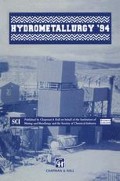Abstract
As the Witwatersrand Basin of South Africa loses its dominance in world gold production, and production from hydrothermal resources continues to increase so there is an upward trend in the exploitation of the so-called refractory zones associated with these deposits.
These ores are pyritic in nature, often containing appreciable quantities of arsenic as arsenopyrite. Much of the gold is occluded in the crystal structure of the sulphide minerals, particularly the arsenopyrite. As a consequence, a much higher level of processing is required when compared to conventional “oxidised” ores, with greater pressure on the environment.
Together with this trend in gold production, significant advancements have been made in the development of alternative recovery technologies. From the environmentally hazardous Edwards roasters through the more sophisticated fluosolids system, to second generation hydrometallurgical processes of pressure and biological oxidation.
The paper demonstrates how technological developments have not only been driven by the normal quest for lower costs and higher recoveries, but in this case by consideration for plant safety and the environment. The modern plant is considered ‐Cenvironmentally safe” with respect to current discharges. However, will they be just as safe in the long term?
Access this chapter
Tax calculation will be finalised at checkout
Purchases are for personal use only
Preview
Unable to display preview. Download preview PDF.
References
Norwood A.F.B. (1939) Roasting and treatment of auriferous flotation concentrates. Proc. Aus.I.M.M. 116, 391–412
Swash P.M. and Ellis P (1986). The roasting of arsenical gold ores: A mineralogical perspective. Gold 100: Proceedings of the International Conference on Gold, SAIMM, Johannesburg
Chryssoulis S.L and Cabric L.J. (1990) Significance of gold mineralogical balances in mineral processing. Trans. Inst. Min. Metall., 99, C1–C9
Connel L. and Cross B. (1981) Roasting process at the Giant Yellowknife mine. 20th Annual conference of Metallurgists. Canadian Institute for Mining and Metallurgy, Hamilton
Da Silva E.J. et al Process selection, design; commissioning and operation of the Sao Bento Mineracao refractory gold ore treatment complex. (Jounal title missing). World Gold ′89, Reno, 322–332
Frostiak J. et al(1990) The application of pressure oxidation at the Campbell Red Lake Mine. Randol Gold Forum. Scaw Valley
Claasen R. (1991) The effect of mineralogy on the bacterial oxidation of refractory gold-bearing sulphides from a Barberton deposit. Colloquium on bacterial oxidation, SAIMM, Johannesburg
Roberts J.L. (1976) Controlling roaster off-gases at Campbell Red Lake Mines. Canadian Mining Journal, 97, 54–56
Robins R.G. (1990) The stability and solubility of ferric arsenate: An update. Proceedings EPD Congress, California, p93
Robins R.G. (1991) Basic ferric arsenates — non existant Randol Gold Forum, Cairns, p197
Krause E. and Ettel V. A.(1989) Solubilities and stabilities of ferric arsenate compounds. Hydrometallurgy, 22, 311
Papassioni N., Stefanakis M. and Kontopoulos A.(1988) Removal of arsenic from solutions by precipi-tation of ferric arsenates. Impurity Control and Disposal. Proceedings of the 15th Annual CDVI Hydrometallurgy Meeting, Canada, 5-1
Broadhurst J.L. (1993) The nature and stability of arsenic residues from the BIOX® process. International Conference and Workshop on Application of Biotechnology to the Mining Industry. Australian Mineral Foundation, Adelaide, 13.1–13.10
US EPA, (1986) Toxicity characteristic leaching procedure. Appendix 1, Federal Register 51(216)
US EPA, (1990) Characteristics of EP toxicity. Paragraph 261.24, Federal Register 45(98)
Roberts N.J. (1992) An evaluation of leach tests applied to metallurgical wastes. MIRO contract no. RC84
Carter A.J. (1991) Economic comparison of alternate methods for recovery of gold from refractory areas. Colloqium on Bacterial Oxidation, SAIMM, Johannesburg
Author information
Authors and Affiliations
Rights and permissions
Copyright information
© 1994 Springer Science+Business Media Dordrecht
About this chapter
Cite this chapter
Haines, A.K. (1994). Environmental impact of increasing production of gold from hydrothermal resources. In: Hydrometallurgy ’94. Springer, Dordrecht. https://doi.org/10.1007/978-94-011-1214-7_3
Download citation
DOI: https://doi.org/10.1007/978-94-011-1214-7_3
Publisher Name: Springer, Dordrecht
Print ISBN: 978-94-010-4532-2
Online ISBN: 978-94-011-1214-7
eBook Packages: Springer Book Archive

